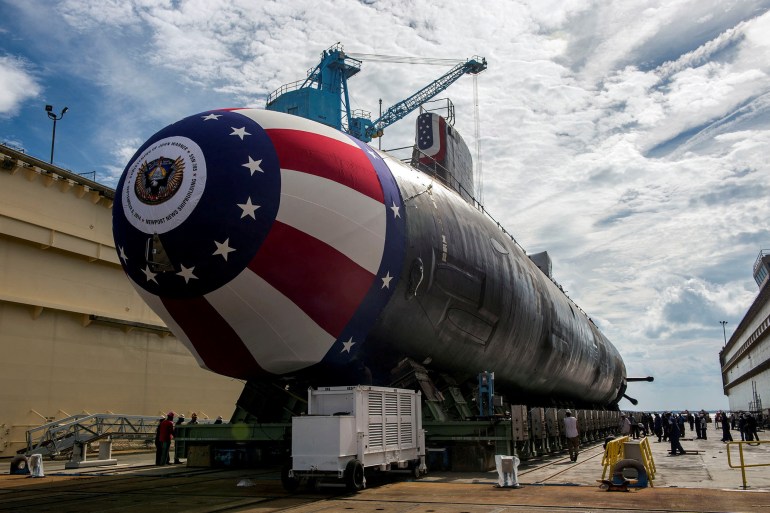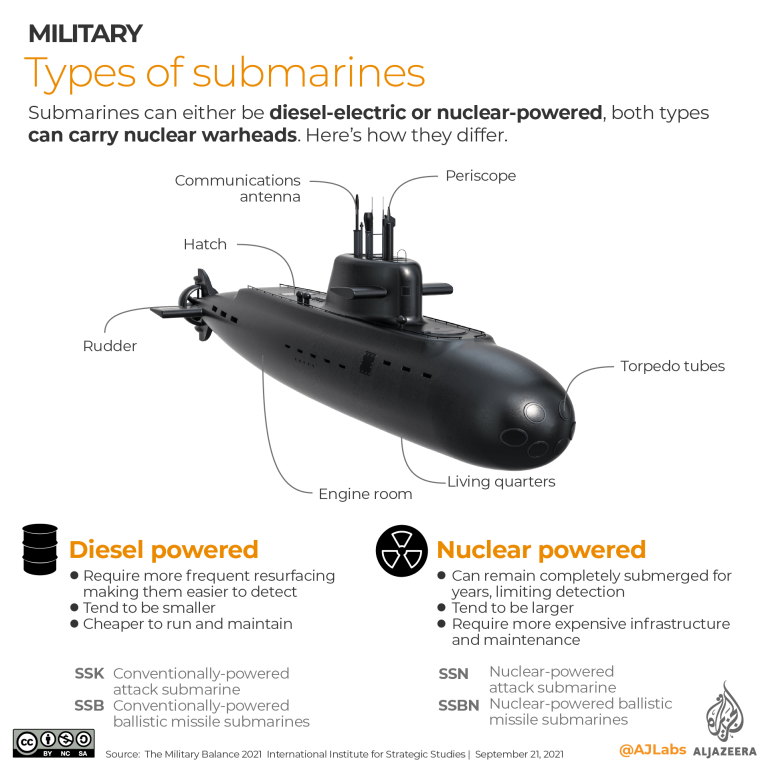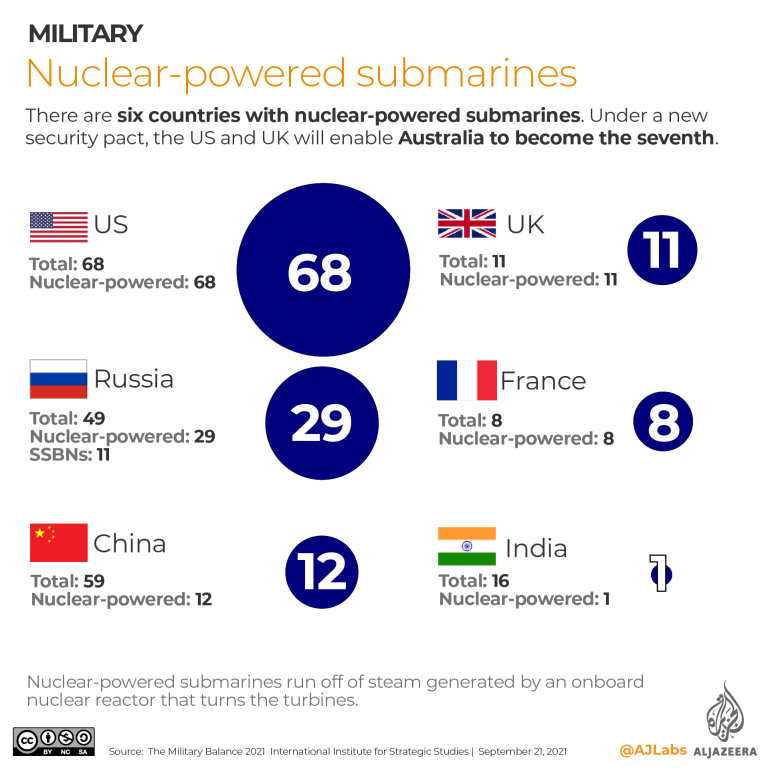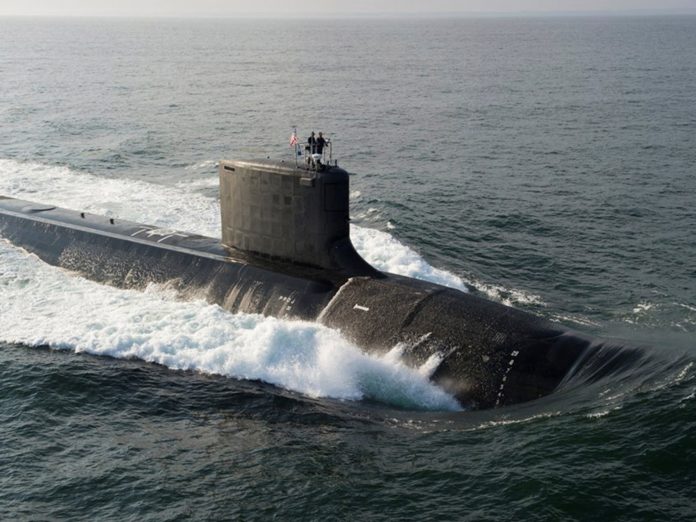EXPLAINER
Acquisition of nuclear-powered submarines has been described as ‘the single biggest leap’ ever in Australia’s defence capabilities.
United States President Joe Biden, Australian Prime Minister Anthony Albanese and United Kingdom Prime Minister Rishi Sunak have unveiled a plan that will see Australia acquire nuclear-powered submarines, allowing the country to become only the seventh in the world with such military technology.
Under the deal, Australia will buy three US Virginia-class nuclear-powered submarines from the US by the early 2030s and has an option to buy two additional vessels if required.
The submarine agreement is part of what is known as the AUKUS pact — an acronym for Australia, the UK and the US — a security agreement that was announced in 2021 by the three countries and seen as a counterweight to China’s growing military presence in the Asia Pacific.
Acquiring nuclear-powered submarines under the AUKUS pact is expected to be Australia’s biggest-ever defence project and the acquisition has been described by the Australian prime minister as “the single biggest leap” in the history of his country’s defence capabilities.
Beijing has made no secret of its opposition to AUKUS and said this month that it “firmly objects” to the pact, accusing the three countries of harbouring a “Cold War mentality” that risks greater escalation in the region.
Australia has stressed that though their new submarines will be nuclear-powered, that does not mean they will be carrying nuclear warheads.
So why does Australia want nuclear-powered submarines, and what is involved in the deal?

Why nuclear-powered submarines?
- Submarines can either be diesel-electric or nuclear-powered and either type can be used to launch nuclear warheads, though Biden also stressed on Monday while announcing the deal that the Australian submarines will not have nuclear weapons on board.
- Diesel-electric submarines involve diesel engines that power electric motors to propel the vessels through the water. But those engines require fuel to operate, which necessitates that the submarines resurface regularly for refuelling.

- When a submarine emerges from the deep and surfaces, it is easier to detect, diminishing its effectiveness as a weapon of stealth.
- Nuclear-powered submarines generate their own energy source — nuclear propulsion technology — and are not as constrained by the need to refuel as diesel-electric subs. They generate steam using an onboard nuclear reactor which is used to turn the vessel’s turbines.
- Nuclear-powered submarines can remain hidden at sea without detection — potentially for years — and are limited primarily by their supplies of food and water for crews.
- “Australia’s submarines face long transits between ports, let alone to potential distant hot spots,” John Blaxland, professor at the Strategic and Defence Studies Centre, Australian National University, wrote of the country’s current conventional submarines. “Advances in artificial intelligence and persistent surveillance make detection easier to the point where a short ‘snort’ to recharge batteries is detectable. To lose stealth is to lose the key advantage of submarines, so something had to give. Nuclear-powered subs can stay underwater for far longer than diesel-electric models,” Blaxland wrote in The Conversation earlier this month.
First transfer of nuclear propulsion technology in six decades
- Compared with conventional submarines, nuclear-powered subs are usually larger and need more expensive infrastructure and maintenance.
- The majority of submarines in operation currently are conventional diesel-electric models, which are smaller and generally cheaper to maintain.
- Australia does not have the expertise to build its own nuclear submarines so it had to buy or acquire the ability to build its fleet from either the US or the UK.
- Australia had originally planned to buy diesel-powered submarines in a 90 billion Australian dollar ($60bn) deal agreed with France in 2016, but it abruptly scrapped that agreement in 2021 in favour of joining AUKUS. The decision set off a diplomatic firestorm with Paris, which has just recently abated with the election of Albanese.
- The submarines deal marks the first time US-derived nuclear submarine technologies have been shared in more than 60 years. The previous and only other time was when Washington helped London design its undersea fleet.
- Under the plan announced on Monday, the UK and Australia will eventually produce and operate a new class of nuclear-powered submarines — SSN AUKUS — which will be jointly built in both countries and will include the latest US technologies.
- Australia’s acquisition of nuclear submarines will place it in a group of just seven countries that have such vessels, joining the US, Russia, China, the UK, France, and India.
AUKUS and fears of a regional arms race
- The Australian submarine deal is part of the AUKUS security agreement Washington, Canberra and London, first announced in September 2021.
- The leaders of the tripartite pact have insisted that AUKUS is not intended to be adversarial towards any other nation. But few doubt that the alliance’s greatest concern is China.
- But the deal has also worried some of Australia’s largest regional allies, with Indonesia and Malaysia questioning whether it could prompt a nuclear arms race in Southeast Asia and the wider Indo-Pacific.
- All three countries have insisted the deal is defensive in nature although having nuclear-powered submarines would give Australia the capability to launch attacks or counterattacks in the event of a conflict.
- Beijing sees the submarine acquisition as a “dangerous” provocation designed to hem China in, but analysts say it should perhaps be more concerned about future collaborative initiatives involving AUKUS, which foresees the allies working together on hypersonic missiles, artificial intelligence and cyber warfare.
- In a joint statement announcing the deal, the three leaders said that their nations had “stood shoulder to shoulder” for more than a century to protect “peace, stability, and prosperity around the world” and also in the Indo-Pacific region. “We believe in a world that protects freedom and respects human rights, the rule of law, the independence of sovereign states, and the rules-based international order. The steps we are announcing today will help us to advance these mutually beneficial objectives in the decades to come,” they said.
- The deal has also faced criticism in the US where the chair of the influential US Senate armed services committee, Democrat Jack Reed, warned Biden in December that selling nuclear-powered submarines to Australia could undermine US naval prowess.
- Referencing the current “darkening clouds in international affairs”, Blaxland of the Australian National University notes that the AUKUS plan is “ambitious, costly” and not without risks. “But these are challenging times. It’s an important plank for bolstering resilience and deterrence and, in turn, reducing the likelihood of adventurism,” he says. “It’s often said that weakness invites adventurism, even aggression.”

Boost for Australian jobs and nuclear industry
- An Australian defence official told the Reuters news agency that the project would cost 368 billion Australian dollars ($245bn) by 2055.
- Though the deal is worth tens of billions of dollars, experts say its significance goes beyond defence.
- AUKUS is expected to be Australia’s largest-ever defence project and offers the prospect of creating jobs not only in Australia but in the UK and the US too.
- Albanese said on Monday that AUKUS would create “20,000 direct jobs for Australians in every state and territory” in the country. “Already, Australian personnel are upskilling on nuclear propulsion technology and stewardship alongside British and American counterparts,” he said in a series of tweets.
- Those jobs are expected to develop over the next 30 years, but Australia would see a 6 billion Australian dollar ($4bn) investment in industrial capacity over the next four years, Albanese said.
It will be a catalyst for jobs, for innovation, and research.
Good jobs, with good wages, working to ensure the stability and prosperity of our nations, our region, and our world. pic.twitter.com/XiQFW3bPr1
— Anthony Albanese (@AlboMP) March 13, 2023

